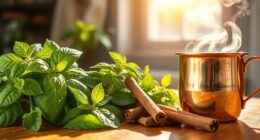We've been relying on plants to heal and prevent illnesses for tens of thousands of years, with ancient ancestors cultivating a profound understanding of their medicinal properties that would eventually shape the course of herbalism. In ancient civilizations like Egypt, Greece, China, and India, herbalism was an integral part of traditional medicine. Documented texts like the Ebers Papyrus and Shennong Ben Cao Jing showcased the medicinal properties of plants, while figures like Hippocrates and Ayurveda practitioners used herbal remedies to treat ailments. As we explore the roots of herbalism, we'll uncover the rich history and cultural influences that have shaped this natural healing practice, leading us further down the path of discovery.
Key Takeaways
• Herbalism dates back tens of thousands of years, with ancient ancestors recognizing medicinal properties of plants for healing and prevention of illnesses.
• Ancient civilizations like Egypt, Greece, China, and India pioneered herbal medicine, documenting medicinal formulas and remedies in texts like Ebers Papyrus and Shennong Ben Cao Jing.
• Traditional healing practices emerged in ancient civilizations, with texts like Shen-Nong-Ben-Cao-Jing and Ayurvedic texts documenting herbal remedies and prehistoric archaeological evidence showing medicinal plant use.
• The contributions of early civilizations, such as Hippocrates, shaped the development of herbal medicine, with figures like Nicholas Culpeper contributing in the Middle Ages.
• Herbal traditions like Traditional Chinese Medicine (TCM), Ayurveda, and Unani medicine have rich historical roots, with monasteries preserving and disseminating herbal wisdom in the Middle Ages.
Ancient Roots of Herbalism
As we explore the history of herbalism, we find that its roots stretch back tens of thousands of years, with evidence suggesting that our ancient ancestors were well-versed in the medicinal properties of plants. This ancient connection between humans and herbs is rooted in traditional medicine, where plants were used to heal and prevent illnesses.
In traditional Chinese medicine, for instance, the Shennong Ben Cao Jing, an ancient text, lists numerous herbs and their medicinal properties. Similarly, in ancient India, Ayurveda, a holistic approach to health, incorporates core herbs like Turmeric and Holy Basil. These ancient texts and practices demonstrate a deep understanding of herbalism, showcasing the significance of plants in ancient medicine.
As we delve deeper into the history of herbalism, we'll uncover more about how our ancestors harnessed the power of plants to create remedies, paving the way for modern herbalism. By examining these ancient roots, we gain a deeper appreciation for the medicinal properties of plants and their enduring role in human health.
Early Civilizations and Herbs

We explore that ancient civilizations, such as Egypt, Greece, and China, played a substantial role in shaping the course of herbalism. These early societies not only recognized the medicinal properties of plants but also developed sophisticated systems of traditional medicine.
In ancient Egypt, the Ebers Papyrus documented over 700 medicinal formulas using plants, while in ancient Greece, Hippocrates utilized herbal remedies like Willow bark in his practice. Meanwhile, traditional Chinese Medicine (TCM) referenced herbs in the Shennong Ben Cao Jing, an ancient Chinese text.
Similarly, Ayurveda, one of the world's oldest healing systems from India, incorporated core herbs like Turmeric and Holy Basil in its treatments. These ancient civilizations' herbal knowledge and tradition have contributed greatly to the development of herbal medicine. Their exploration of medicinal plants and herbal remedies laid the foundation for our understanding of herbalism today.
As we investigate the history of herbalism, we're reminded of the importance of these early civilizations in shaping our understanding of herbal ingredients and their role in traditional medicine.
Herbal Medicine Through Ages

Through the ages, herbal medicine has evolved considerably, shaped by the contributions of diverse cultures and individuals who recognized the healing potential of plants. As we explore the history of herbal medicine, we find that it's a rich tapestry of ancient traditions and innovative breakthroughs.
- In ancient China, traditional herbal remedies were developed, which still form the basis of Traditional Chinese Medicine (TCM) today.
- The Ebers Papyrus and writings of Hippocrates demonstrate the use of herbal remedies in ancient Egypt and Greece.
- Herbalism gained prominence in the Middle Ages, with figures like Nicholas Culpeper contributing to our understanding of medicinal herbs.
- The 18th century saw significant contributions to herbal medicine, with diverse communities and prominent figures like Harriet Tubman playing key roles in herbal remedies.
From ancient civilizations to modern-day practitioners, herbal medicine has been shaped by the collective knowledge of many cultures. As we investigate the history of herbalism, we're reminded that the use of medicinal herbs is a timeless tradition that continues to evolve to this day.
Traditional Healing Practices Emerge

We've inherited a rich legacy of traditional healing practices from ancient civilizations, where herbalism emerged as a cornerstone of healthcare. In ancient civilizations like Egypt, Mesopotamia, India, China, Greece, and Rome, herbalism played a significant role in traditional healing practices.
We find evidence of this in texts like Shen-Nong-Ben-Cao-Jing, which documented herbal remedies in Chinese herbal medicine, and Ayurvedic texts in India, dating back thousands of years. These practices, such as Traditional Chinese Medicine (TCM), Ayurveda, and Unani medicine, have rich historical roots and holistic approaches to healthcare.
We also know that the use of plants for medicinal purposes predates written human history, with archaeological evidence showing medicinal plant use dating back to the prehistoric era. It's clear that traditional healing practices have been passed down through generations, with monasteries playing a significant role in preserving and disseminating herbal wisdom in the Middle Ages.
The Birth of Herbal Traditions

As we explore the birth of herbal traditions, ancient civilizations like Egypt, Greece, China, and India emerge as pioneers in harnessing the power of plants for medicinal purposes. These civilizations recognized the potential of herbal remedies and developed sophisticated systems to harness their power.
Some notable examples include:
- Egypt: The Ebers Papyrus documents over 700 herbal formulas around 1500 BCE, showcasing their advanced understanding of herbalism.
- Greece: Hippocrates, the father of Western medicine, utilized herbal remedies like Willow bark in his practice, laying the groundwork for future herbal traditions.
- China: Traditional Chinese Medicine (TCM) established a rich herbal tradition with the legendary figure Shen-Nong cataloging hundreds of herbs in the Shennong Ben Cao Jing, a precursor to the Chinese Pharmacopoeia.
- India: Ayurveda, an ancient Indian healing system dating back to 3300 BCE, incorporates core herbs like Turmeric and Holy Basil for holistic health practices.
These ancient civilizations paved the way for future herbal traditions, influencing the development of herbal remedies and shaping our understanding of plant-based medicine.
Frequently Asked Questions
Where Did Herbalism Come From?
We're often curious about the origins of herbalism, wondering where it came from. The truth is, herbalism has its roots in ancient civilizations.
We find evidence of herbal remedies dating back to Neanderthals around 60,000 BCE, and ancient texts like the Ebers papyrus and Shennong Ben Cao Jing showcase the early development of herbal practices.
These historical roots have evolved over time, shaping the diverse and complex system of herbalism that's familiar to us today.
Who Started Herbal Medicine?
As we explore the origins of herbal medicine, we find ourselves wandering through ancient civilizations. We imagine the whispers of Shen-Nong, the legendary Chinese emperor, as he discovers the healing properties of plants.
But who started herbal medicine? The truth is, it's a collective effort. From ancient Egyptians to Ayurvedic practitioners, many cultures have contributed to the development of herbalism. We can't pinpoint a single founder, but rather a rich tapestry of knowledge woven by diverse cultures and individuals throughout history.
How Were Herbs First Discovered?
We've uncovered evidence that herbs were first discovered through observing nature and trial-and-error experimentation. Archaeological findings, such as willow, St. John's wort, and chamomile residues in Neanderthal tooth plaque, suggest that early humans stumbled upon herbal remedies by accident.
It's likely that our ancient ancestors observed the healing properties of plants while foraging for food, and then passed on this knowledge through generations.
Who Is the Father of Herbalism?
We attribute the title 'father of herbalism' to Dioscorides, a Greek physician and botanist who wrote the extensive herbal encyclopedia 'De Materia Medica' in the 1st century AD. His work cataloged over 600 medicinal plants and their uses, influencing generations of healers and herbalists.
Dioscorides' systematic approach laid the groundwork for the scientific study and application of herbs in healthcare. His legacy endures, with his work continuing to be referenced and studied in the field of herbal medicine.
Conclusion
As we conclude our journey through the ancient roots of herbalism, we're left with more questions than answers.
What secrets lie hidden in the uncharted territories of traditional healing practices?
How will the convergence of modern science and ancient wisdom shape the future of herbal medicine?
The mystery unfolds, beckoning us to continue exploring the labyrinth of herbalism, where the past, present, and future converge in a delicate dance of discovery.










